Hot tub wiring is the most critical aspect of spa installation. It involves a dangerous mix of electricity and water that demands professional expertise and strict adherence to safety codes. A mistake can mean the difference between relaxation and tragedy. Most hot tubs require a dedicated 240-volt circuit with 50 or 60-amp GFCI protection, along with specific grounding and bonding.
Quick Hot Tub Wiring Requirements:
As one electrical expert notes: "There are few things more pleasurable than a long soak in a hot tub... it's truly a treat to immerse your tired body into hot, roiling water." However, this pleasure depends entirely on a safe, professional electrical installation.
The combination of water and electricity creates serious risks of electrocution, fire, and equipment damage. The Canadian Electrical Code (CEC) has strict rules because even low voltage can be fatal when water is involved. Understanding the basics of hot tub electrical requirements is key to making informed decisions for your home.
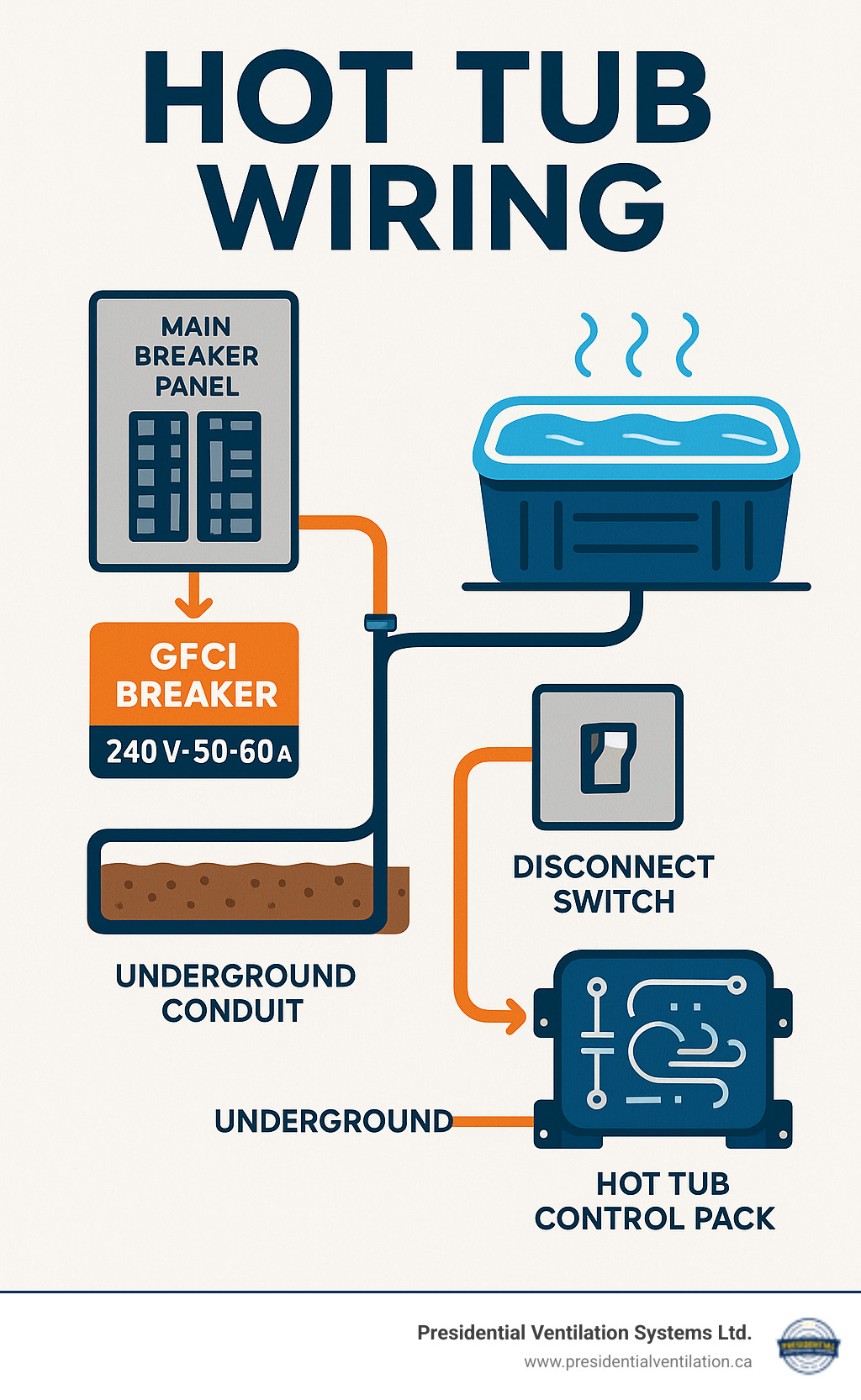
This initial phase is crucial for a safe and cost-effective installation. Proper planning for your hot tub wiring prevents unexpected costs, delays, and safety hazards. It involves understanding your spa's power needs, assessing your home's electrical system, and handling placement and permits correctly.
Hot tubs are power-hungry appliances that require their own dedicated circuit. Your manufacturer's manual will specify the exact voltage and amperage required. Generally, hot tubs fall into two categories:
Feature120V Plug-and-Play Hot Tubs240V Hard-Wired Hot TubsHeating SpeedSlower, especially in cold weatherMuch faster, more efficientPump PowerLower, may not run all jets and heater simultaneouslyHigher, runs all features at full powerInstallationSimpler, plugs into standard outletMore complex, requires dedicated circuit and professional wiringTypical CostLower initial electrical setup costHigher initial electrical setup cost
Before installation, we must confirm your home's electrical system can handle the load. Most modern homes with 100-amp service or better are sufficient, but we will perform a load calculation to be certain. We also check for available breaker slots, as a 240V hot tub needs a double-pole breaker that takes two adjacent spots. If your panel is full or undersized, an Electrical Service Upgrade may be necessary for safety and reliability.
Location significantly impacts hot tub wiring cost and safety. Placing the spa closer to the main electrical panel reduces material and labor costs. However, safety is paramount, and the Canadian Electrical Code (CEC) dictates placement rules.
Using the correct, high-quality materials is non-negotiable for a safe, long-lasting installation. The outdoor environment in Nova Scotia is harsh on electrical components, so every part of the hot tub wiring system must be rated for the job. Cutting corners on materials is dangerous and can lead to system failure.
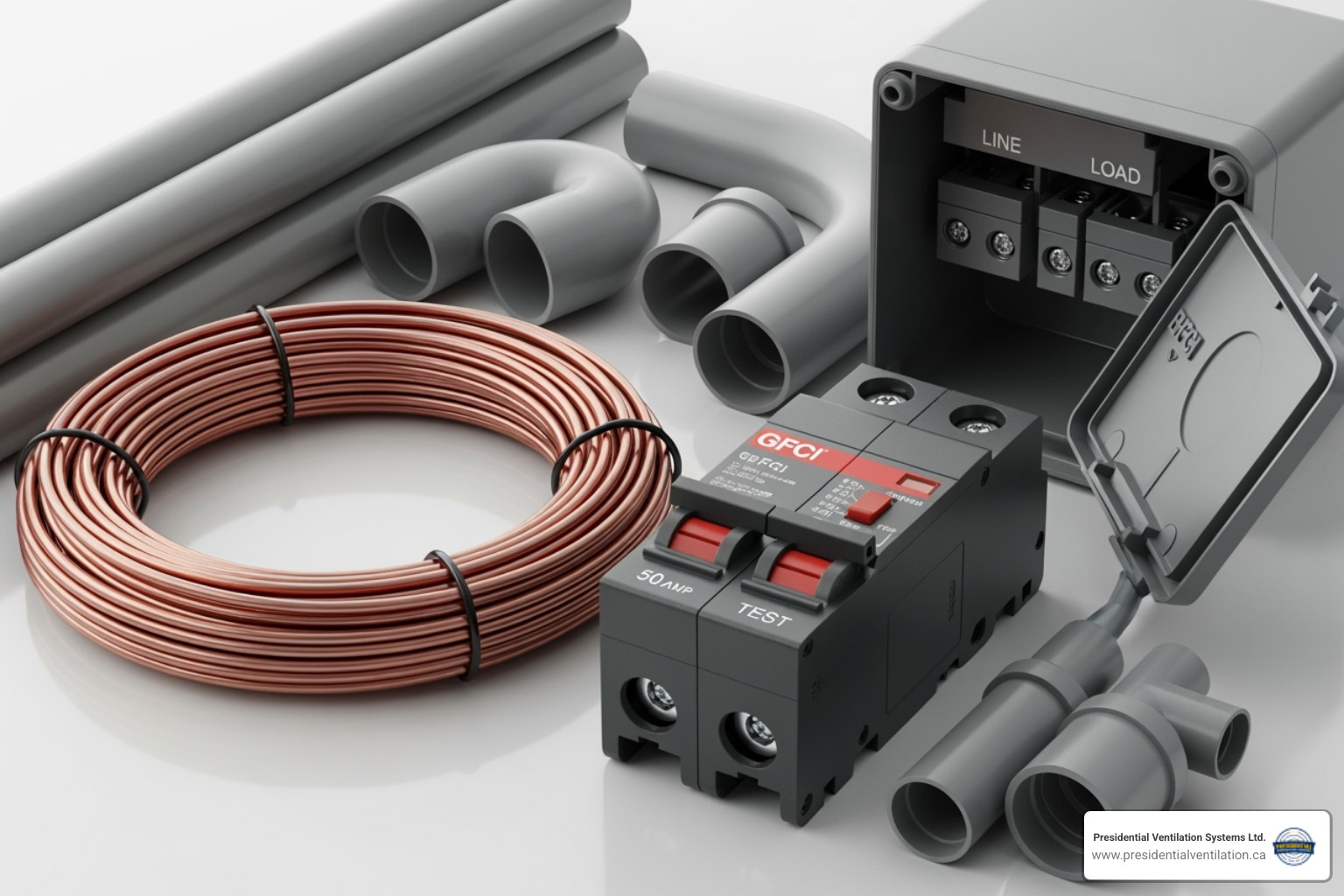
Every component is chosen to withstand moisture, temperature changes, and physical stress.
These two components are the most important safety devices in the entire system.
The Ground Fault Circuit Interrupter (GFCI) provides essential shock protection. It constantly monitors the electrical current and will shut off power in milliseconds if it detects a ground fault (e.g., current leaking through water). This rapid response is fast enough to prevent serious injury or electrocution. While nuisance tripping can sometimes occur, a properly installed system minimizes this while ensuring safety.
The manual disconnect switch (or spa panel) is the required emergency shut-off. The Canadian Electrical Code mandates it be located within sight of the spa, at least 1.5 meters away from the water, but no more than 15 meters away. This allows anyone to quickly cut power in an emergency and provides a safe way to de-energize the unit for maintenance.
This process involves significant risk and should only be performed by a qualified professional. Hot tub wiring combines high voltage and water, a combination that can be deadly if not handled with expertise. This overview outlines the professional steps we take to ensure a safe, code-compliant installation.
The first step is building the electrical foundation. After shutting off main power for safety, we install a dedicated 2-pole GFCI circuit breaker in your main service panel, sized to your spa's amperage rating (e.g., 50 or 60 amps). Next, we mount the weatherproof disconnect box (spa panel) on a sturdy surface. Per the Canadian Electrical Code, this box must be within sight of the tub, at least 1.5 meters away but no more than 15 meters. Our Electrical Hookup Services ensure these steps are done with precision.
This phase creates a safe pathway for the electricity.
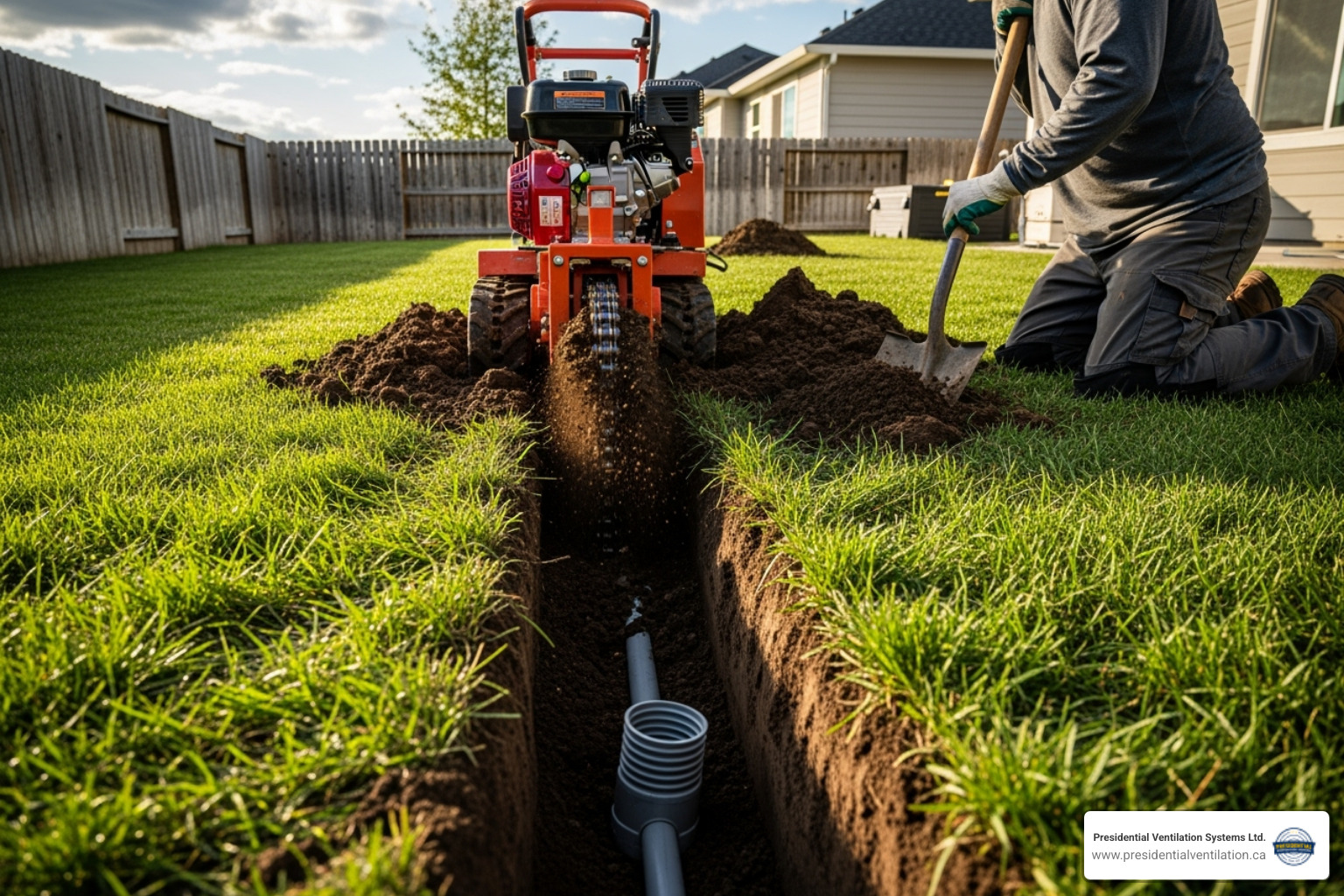
If the spa is far from the panel, we dig a trench to a depth of at least 18 inches. We then run rigid PVC conduit from the disconnect box to the spa's location, using sweep elbows for gentle turns to make pulling wires easier. Using fish tape and wire lubricant, we pull the four #6 AWG copper conductors (two hot, one neutral, one ground) through the conduit, leaving adequate slack at both ends for secure connections.
This final stage completes the safety system. Grounding provides a path for fault current to trip the breaker, while bonding is equally critical. Bonding involves connecting all metal components within 1.5 meters of the spa (ladders, handrails, etc.) with a solid copper wire to create an equipotential bonding grid. This prevents dangerous voltage differences between surfaces.
We then connect the 4-wire system to the spa's control pack according to the manufacturer's diagram. We ensure all terminals are tightened securely to prevent overheating and arcing. A common DIY error is incorrect neutral wire placement, which causes immediate GFCI tripping. Finally, we test the entire system for continuity, voltage, and proper GFCI function before energizing the circuit.
While the DIY spirit is admirable, hot tub wiring is a job where the risks of going it alone far outweigh any potential savings. The combination of high-voltage electricity and water is unforgiving.
Attempting to wire a hot tub yourself can have severe consequences:
Hiring Presidential Ventilation Systems Ltd. provides more than just connected wires; it provides safety and peace of mind.
Here are answers to the most common questions we receive about hot tub wiring from homeowners across Nova Scotia.
Professional hot tub wiring costs can vary significantly, but typically range from several hundred to a few thousand dollars. The final price depends on several factors:
A tripping GFCI is a safety feature indicating a problem. Do not ignore it. Common causes include:
The CEC has strict, life-saving rules for hot tub installations. Key requirements include:
Your hot tub should be a source of relaxation, not a cause for worry about electrical safety. While the end result is pure bliss, safe hot tub wiring requires professional expertise. Proper planning, correct materials, and strict code compliance are not just about passing inspections—they are about protecting your family from the serious risks of fire and electrocution.
The combination of water and high-voltage electricity demands respect and the skill of a licensed electrician.
At Presidential Ventilation Systems Ltd., we have over 30 years of experience helping families across Nova Scotia create safe backyard retreats. Our licensed electricians live and breathe the Canadian Electrical Code, ensuring every installation is done right the first time. We bring the same commitment to excellence to our electrical work as we do to our HVAC and insulation services, backing it with solid warranties for your peace of mind.
Don't risk your family's safety with a DIY installation. Ensure your backyard oasis is a source of relaxation, not risk. For a safe, compliant, and worry-free installation from a trusted local professional, get your Electrical Services in Halifax, NS done right. We serve communities from Kentville and Truro to Dartmouth and Bridgewater, and everywhere in between. Let us get you wired for pure, worry-free enjoyment.
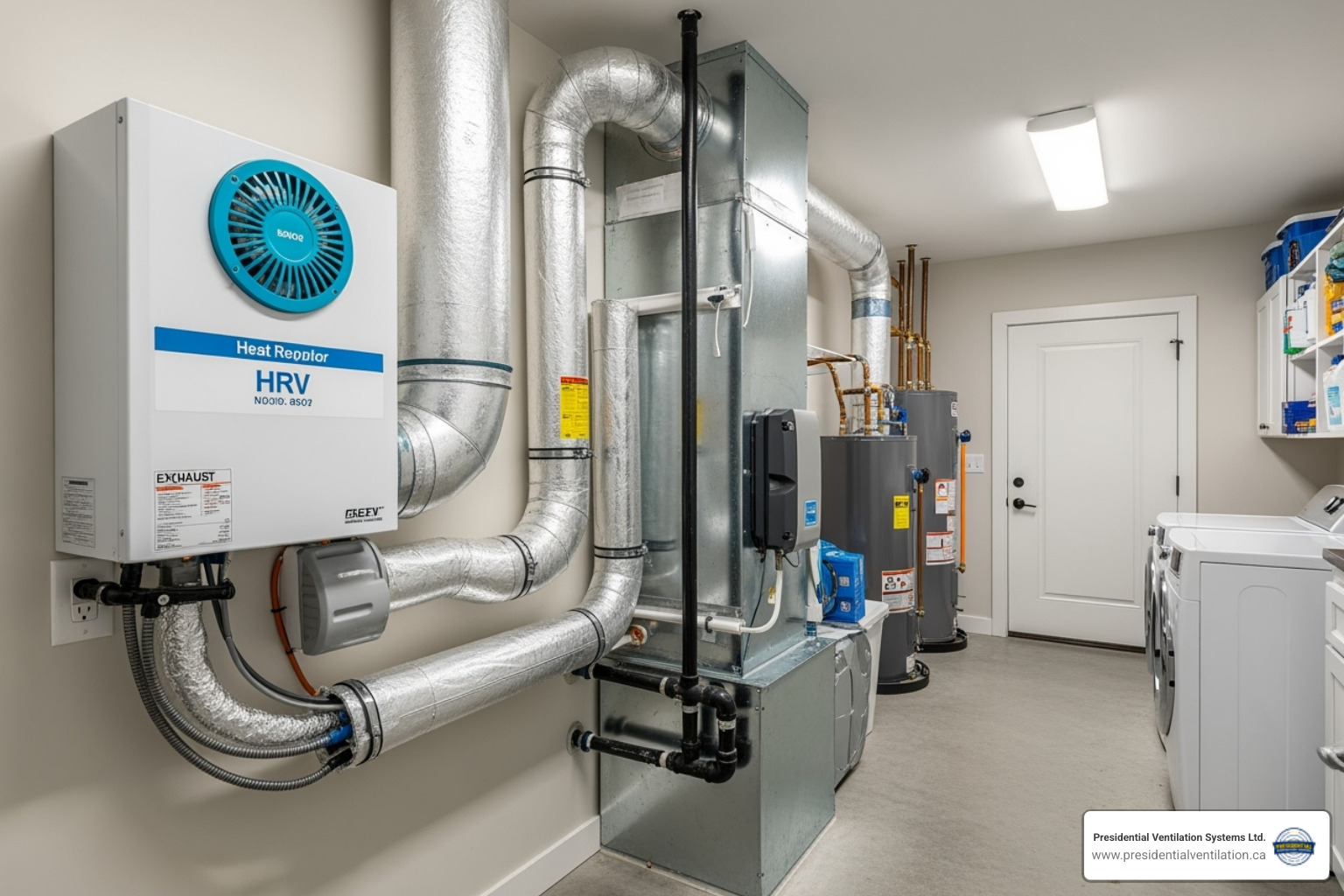

Mechanical ventilation design prospect NS refers to the planning, implementation, and regulatory compliance of controlled ventilation systems in Nova Scotia homes and buildings. Here's what you need to know:
Quick Answer: What is Mechanical Ventilation Design in Nova Scotia?
You've probably heard the phrase "homes need to breathe." It's true, but not in the way you might think.
To combat rising energy costs and Nova Scotia's harsh climate, modern homes are built to be incredibly airtight. While this is great for your heating bill, it's terrible for indoor air quality without proper ventilation. Without fresh air exchange, moisture builds up, mold grows, and allergens and pollutants get trapped inside with nowhere to go.
That's where mechanical ventilation comes in. Unlike cracking a window (which wastes energy), systems like HRVs and ERVs bring in fresh outdoor air while recovering heat from the stale air going out. It's smart, efficient, and increasingly required by building codes across the province.
This guide will walk you through Nova Scotia's mechanical ventilation design regulations, explain why they exist, and help you understand what a proper system looks like—whether you're building new, renovating, or improving your home's air quality.
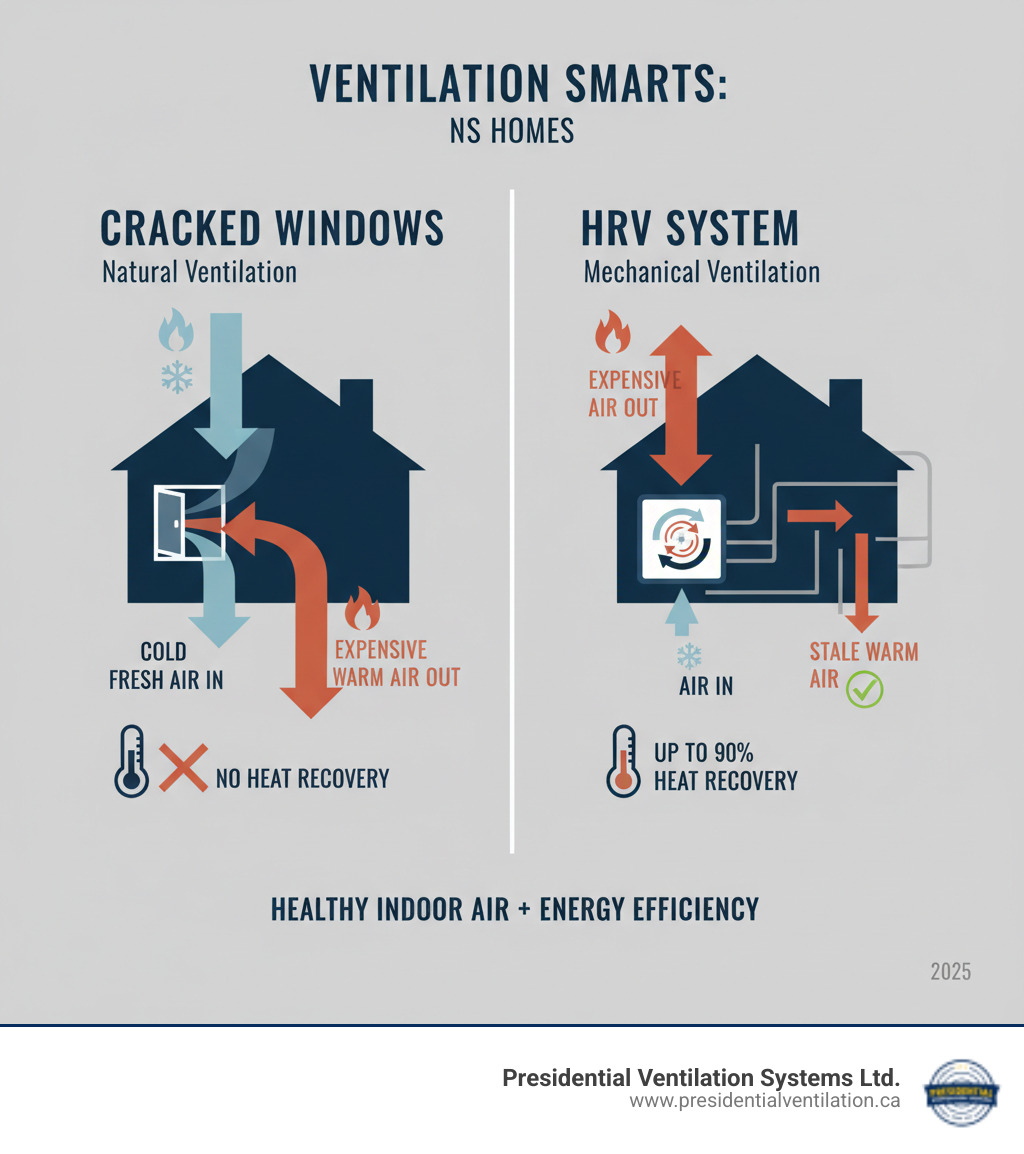
Let's talk about why mechanical ventilation design prospect NS has become so critical. It's not just about ticking boxes on building permits—it's about protecting your family's health, your home's structure, and your energy bills.
Modern homes are built to be extremely tight to keep heat in during our long winters and cool air in during humid summers. The catch? A sealed home traps everything inside: moisture, cooking odors, allergens, and chemical vapors (VOCs). The Nova Scotia Building Code, following the National Building Code of Canada (NBCC), recognized this problem and now requires mechanical ventilation in new construction. This ensures healthy indoor air from day one.
Unlike old, drafty homes that lost huge amounts of energy, modern ventilation systems like HRVs and ERVs are highly efficient. They recover energy from the outgoing stale air and transfer it to the incoming fresh air. You get continuous fresh air without the high energy penalty, dramatically reducing heating and cooling costs.
Nova Scotia is humid. In an airtight home, moisture from cooking, showering, and even breathing has nowhere to go. It condenses on cold surfaces like windows, leading to peeling paint, rotting frames, and mold growth. A well-designed mechanical ventilation system actively removes this excess moisture before it can cause damage, preventing condensation by continuously exchanging humid indoor air for drier outdoor air.
Your home can trap allergens like dust mites, pet dander, and pollen, making symptoms worse for allergy sufferers. Mechanical ventilation helps by constantly flushing out these airborne irritants and replacing them with filtered fresh air. This continuous air turnover can significantly reduce allergen concentrations.
Additionally, parts of Nova Scotia have liftd levels of radon, a naturally occurring radioactive gas and a leading cause of lung cancer. In an airtight home, radon can accumulate to dangerous levels. Mechanical ventilation provides consistent air changes that dilute and exhaust radon, protecting your family from this invisible health risk.
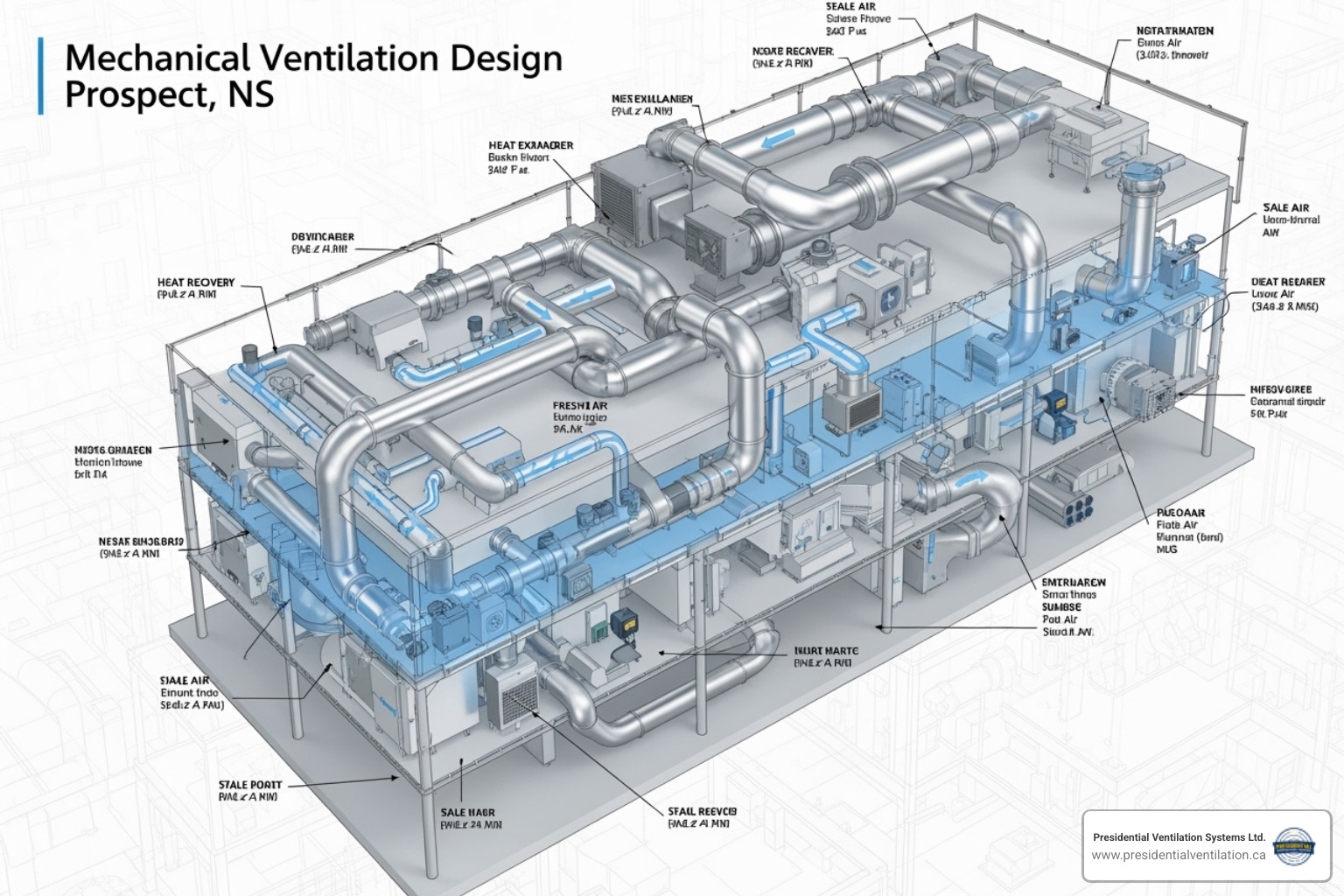
A properly designed system is an investment in your family's health, your home's durability, and your long-term comfort. For more details, explore our HRV System Benefits.
When discussing mechanical ventilation design prospect NS, we're usually talking about two systems: Heat Recovery Ventilators (HRVs) and Energy Recovery Ventilators (ERVs). Both exhaust stale indoor air while bringing in fresh outdoor air, using a heat exchange core to transfer energy.
The key difference is moisture. HRVs transfer heat only, which helps reduce indoor humidity in the winter. ERVs transfer both heat and moisture. This is crucial for Nova Scotia's humid summers, as an ERV can remove moisture from the incoming air, helping to dehumidify your home. Given our climate, ERVs are often the preferred choice for year-round comfort.
Designing and installing a mechanical ventilation system in Nova Scotia requires navigating a framework of regulations. These rules ensure systems are safe, effective, and deliver healthy indoor air. When we talk about mechanical ventilation design prospect NS, we're talking about creating systems that meet both the letter and the spirit of the law.
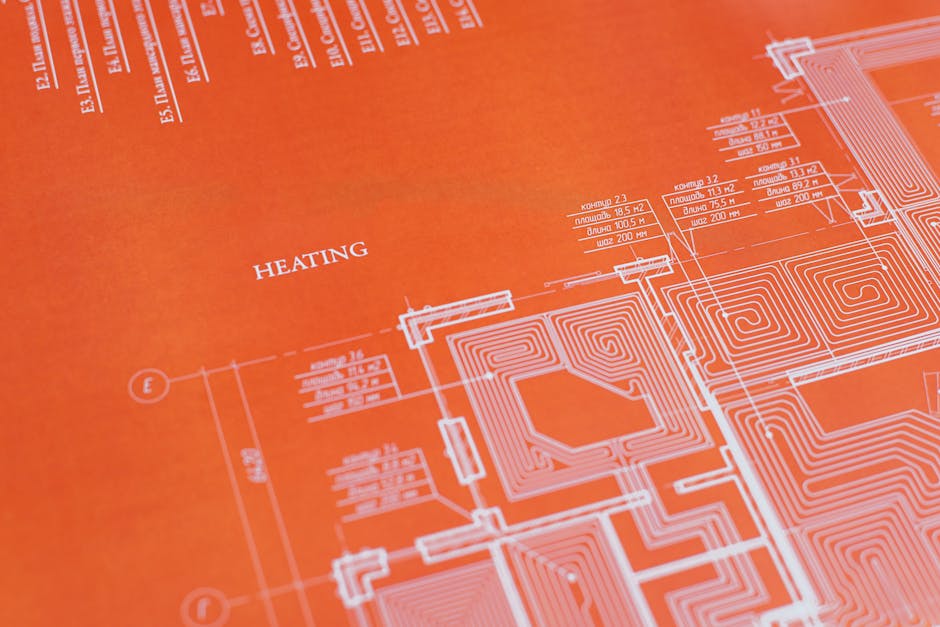
These standards are guardrails that protect homeowners from poor design and ensure contractors deliver quality work.
Compliance isn't just about paperwork; it protects your health, home, and wallet. A code-compliant system prevents the buildup of harmful gases and pollutants, controls moisture to stop mold and rot, and operates efficiently to save energy. Furthermore, most manufacturer warranties require professional, code-compliant installation. Cutting corners can void your warranty and lead to costly repairs.
Getting mechanical ventilation design prospect NS right means focusing on the details. It's about creating a complete system that works seamlessly with your home.
Our HRV Installation Halifax Guide 2025 dives deeper into these design elements.
Commercial systems operate on a much larger scale. Key differences include:
For a comprehensive look, see our Commercial Ventilation Halifax Ultimate Guide.
The world of mechanical ventilation design prospect ns is constantly evolving with new technology for smarter, more efficient systems. If you're building or upgrading, these innovations are worth knowing about.

Modern ventilation systems are becoming intelligent, adjusting automatically to your home's needs. Demand-controlled ventilation (DCV) uses sensors to monitor conditions and respond in real-time. For example, CO2 sensors detect when a room is occupied and increase airflow, then dial it back to save energy when the room is empty.
Smart home integration allows you to control your system via a smartphone app or voice assistant, setting schedules that match your routine. We're also seeing more accessible advanced HEPA filtration, which captures ultrafine particles, bacteria, and viruses, offering superior protection for those with respiratory concerns. These smart systems can also improve acoustic comfort by running at quieter speeds when needed, ensuring better sleep without sacrificing air quality.
High-performance building standards like net-zero homes and Passive House rely on two key elements: exceptional insulation and incredibly efficient mechanical ventilation. These homes are so airtight that an HRV or ERV is not just an add-on; it's a core component for achieving their energy targets.
ECM motors (Electronically Commutated Motors) are now standard in quality ventilation equipment. They use significantly less electricity than older motors, running more quietly and saving you money on utility bills. This focus on efficiency is a key part of sustainable design, helping reduce our collective carbon footprint.
Even the most advanced system needs regular care to run well. Think of it like your car—it needs tune-ups to maintain performance.
Regular maintenance ensures your system delivers fresh, healthy air efficiently for years to come. For more details, check out our guide on HRV Duct Cleaning.
We talk to homeowners across Nova Scotia every day about mechanical ventilation design prospect NS. Here are answers to the most common questions.
Yes, it's still highly recommended. Drafts are uncontrolled, unfiltered, and unreliable. They let in pollen, dust, and exhaust without guaranteeing fresh air reaches the rooms where you need it. Meanwhile, moisture still builds up in bathrooms and kitchens, leading to localized mold and musty odors.
Mechanical ventilation gives you control. A bathroom exhaust fan removes moisture at the source. A kitchen hood vents cooking odors outside. An HRV or ERV provides a constant supply of filtered, fresh air to your living spaces while removing stale, humid air from problem areas. It provides consistent, predictable air exchange that improves comfort and protects your home, regardless of how airtight it is.
The short answer is continuously. Modern HRVs and ERVs with efficient ECM motors are designed for 24/7 operation. This maintains a steady supply of fresh air and keeps humidity levels stable, preventing pollutants from accumulating. Think of it like your refrigerator—it runs constantly but efficiently to do its job.
Many systems have automatic controls that adjust fan speed based on humidity or outdoor temperature, so it's not always running at full blast. There are also boost modes for when you need extra ventilation, like after painting or hosting a party. The baseline, however, should be continuous, low-level operation for optimal air quality.
While we admire the DIY spirit, this is a job for professionals. Proper installation requires a deep understanding of building codes (NBCC, CSA F326), airflow calculations, ductwork design, and system balancing. An improperly installed system can fail inspection, void the manufacturer's warranty, and even worsen your indoor air quality by creating pressure imbalances or pulling in contaminated air.
We've seen DIY jobs that caused backdrafting from furnaces or recycled stale air instead of exhausting it. Professional installation ensures your system is sized correctly, integrated properly, and optimized for Nova Scotia's climate. Our team at Presidential Ventilation Systems Ltd. has over 30 years of experience getting it right the first time. For comprehensive support, explore our HVAC Services Halifax HRM NS offerings.
We've covered the essentials of mechanical ventilation design prospect NS, from why it's needed to the regulations that govern it. The takeaway is clear: modern, airtight homes in Nova Scotia's climate require mechanical ventilation to protect against moisture damage and ensure healthy indoor air.
Systems like HRVs and ERVs are required by code for good reason. They keep your air fresh while recovering energy that would otherwise be wasted. Innovations like smart controls and advanced filtration are making these systems more effective and efficient than ever.
However, even the best equipment will fail if it's not designed and installed by a professional. Proper sizing, ductwork design, and system balancing are critical steps that require expertise. This is not a DIY project—your family's health and your home's integrity are on the line.
At Presidential Ventilation Systems Ltd., we have over 30 years of experience designing and installing ventilation systems across Nova Scotia, including Halifax, Dartmouth, Bedford, and the surrounding areas. Our certified professionals ensure your system is compliant, efficient, and perfectly suited to your home.
Ready to improve your home's air quality? Explore our expert HRV Systems solutions and let us help you create a healthier, more comfortable home environment.


Residential ventilation installation dartmouth ns involves professionally adding a mechanical ventilation system—typically a Heat Recovery Ventilator (HRV) or Energy Recovery Ventilator (ERV)—to your home to continuously exchange stale indoor air with fresh outdoor air while recovering heat energy. Here's what you need to know:
Quick Guide to Residential Ventilation Installation in Dartmouth:
Modern houses are built to be airtight. That's great news for your heating bills, but it creates a hidden problem: your home can't breathe.
Without proper ventilation, your Dartmouth home becomes a sealed container. Every shower adds moisture. Every meal leaves odors. Pet dander, dust, and volatile organic compounds from furniture and cleaning products have nowhere to go. The result? Condensation on windows, musty smells, potential mold growth, and worsening allergy symptoms.
Dartmouth's climate makes this challenge worse. Cold winters mean homes stay sealed tight for months. Humid summers can bring moisture problems. Your home needs a ventilation system that works year-round.
The good news? A professionally installed ventilation system solves these problems while recovering up to 95% of your home's heat energy. You get fresh air without wasting the warmth you paid to create.
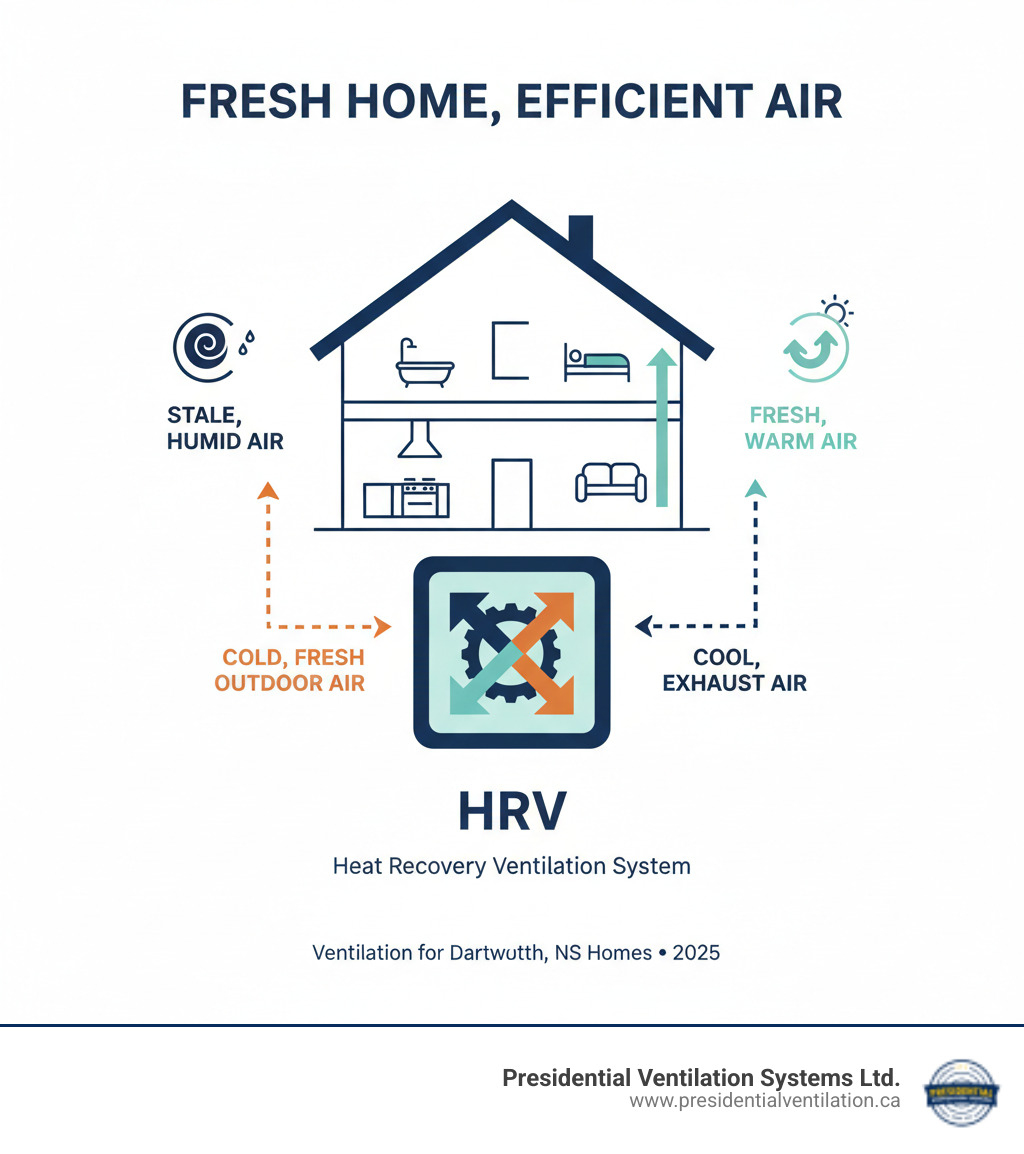
You know that moment when you walk into your house after a weekend away and something just smells... off? Or maybe you're constantly wiping moisture from your windows every winter morning. These aren't just small annoyances—your home is trying to tell you something important.
Modern homes are wonderfully energy-efficient, which is great for your wallet. But that same airtight construction that keeps your heating bills low can also trap everything inside: moisture, odors, allergens, and pollutants. Without proper air circulation, you're essentially living in a sealed box.
Here's how to recognize when your Dartmouth home needs a residential ventilation installation dartmouth ns:
Condensation on windows is a key clue. While a little morning fog is normal, constant water droplets are a red flag. This excess moisture can lead to mold and damage your window frames.

Stale or musty odors that linger are another sign. If cooking smells stick around or the air feels stuffy, it's because poor circulation traps them inside.
Visible mold or mildew is the most serious sign. Dark patches in corners, on basement walls, or behind furniture indicate a ventilation problem. Mold thrives in damp, stagnant air and is a serious health hazard.
Worsening allergy symptoms indoors can point to poor air quality. If you sneeze or cough more at home, your air may be the culprit. Without fresh air, pollutants like dust, dander, and VOCs build up.
High indoor humidity feels uncomfortable. You might notice a sticky feeling in the air, especially during Dartmouth's humid summers, making your home feel warmer and forcing your AC to work overtime.
When you address these ventilation issues, the improvements touch every aspect of your home life.
Improved health is the most important benefit. A proper ventilation system continuously dilutes and removes indoor pollutants. That means fewer allergens, less dust, and cleaner air for your family to breathe. You'll notice the difference—fewer morning sniffles, less nighttime coughing, and an overall feeling of freshness in your home.
Energy savings might surprise you. It seems backwards—bringing in outside air to save energy? But modern Heat Recovery Ventilators (HRVs) and Energy Recovery Ventilators (ERVs) are remarkably clever. They recover up to 95% of the heat from your outgoing stale air and transfer it to the fresh incoming air. You get ventilation without throwing your heating dollars out the window. Your furnace and air conditioner work less, and your energy bills drop.
Home protection is the long-term payoff. By controlling humidity levels, ventilation systems prevent the moisture damage that can quietly destroy your home's value. No more mold growth. No wood rot. No peeling paint or warped floors. Your home stays healthier, and so does your investment.
Common indoor air pollutants that proper ventilation helps eliminate include dust mites and their droppings, pet dander, pollen that sneaks in from outside, VOCs from paints, cleaning products, and furniture, excess carbon dioxide from breathing, moisture from cooking and showering, formaldehyde from pressed wood products, and even radon gas (which gets diluted, though severe radon problems need specialized mitigation).
The signs are clear. The solution is straightforward. If your Dartmouth home is showing any of these symptoms, it's time to consider professional residential ventilation installation dartmouth ns that addresses the root cause.
When you're ready to improve your home's air quality with a residential ventilation installation Dartmouth NS, you'll want to understand your main options: Heat Recovery Ventilators (HRVs) and Energy Recovery Ventilators (ERVs). Both are balanced ventilation systems that bring fresh outdoor air into your home while pushing stale indoor air out. The clever part? They do this without wasting the energy you've already spent heating or cooling your home.
Think of these systems as your home's lungs, constantly breathing in fresh air and exhaling the old. But which one is right for your Dartmouth home?
HRVs are winter warriors, ideal for Nova Scotia's cold climate. As warm, stale air exits, it passes through a heat exchanger core, warming the incoming cold, fresh air without the two streams mixing. This pre-warmed air reduces the load on your furnace or heat pump, saving on heating bills. If your main goal is retaining heat in winter while ensuring fresh air, an HRV is an excellent choice.
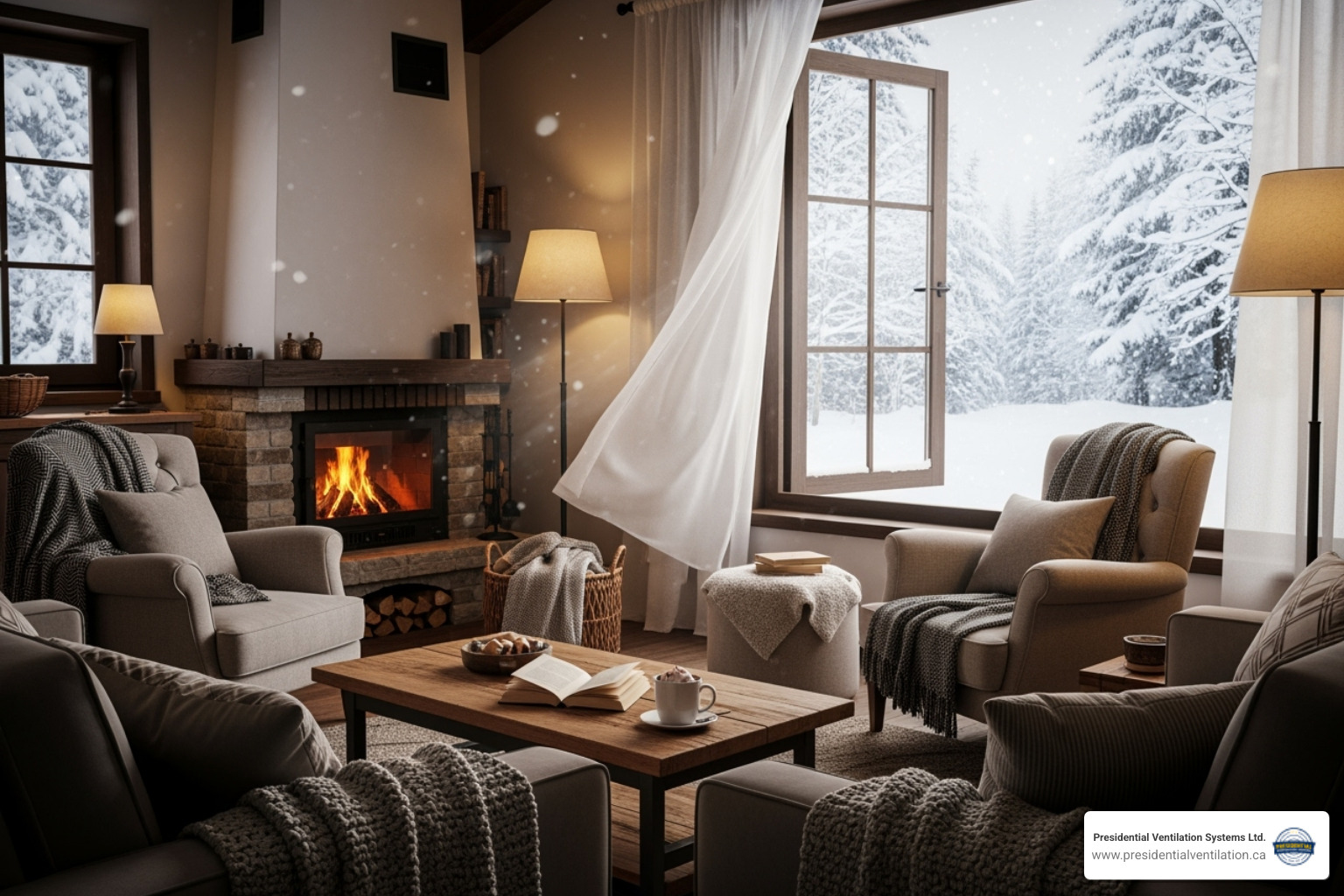
ERVs handle both temperature and humidity. Like an HRV, an ERV transfers heat. But it also transfers moisture. In winter, it retains some indoor humidity, preventing overly dry air. In summer, it removes humidity from the incoming hot air, reducing the load on your air conditioner and making your home more comfortable. For managing humidity during Dartmouth's sticky summers, ERVs are hard to beat.
So which system should you choose? The answer depends on what matters most to you and how your home behaves throughout the year.
| Feature | Heat Recovery Ventilator (HRV) | Energy Recovery Ventilator (ERV) |
|---|---|---|
| Primary Function | Transfers heat between air streams. | Transfers both heat and moisture between air streams. |
| Winter Benefit | Recovers heat from outgoing air, pre-warming incoming air. Best for cold, dry climates. | Recovers heat and transfers some indoor humidity to drier incoming air. |
| Summer Benefit | Brings in fresh air, but doesn't manage humidity. | Transfers heat from incoming air and removes excess moisture. Best for hot, humid climates. |
| Ideal Climate | Cold, dry winters (like much of Dartmouth's winter). | Humid summers and mixed climates (like Dartmouth's summers and shoulder seasons). |
| Moisture Transfer | Minimal | Significant |
Dartmouth's climate is interesting because we experience both extremes. Our winters are cold and often dry, while our summers can be warm and humid. For this reason, many homeowners find that an ERV offers the best year-round comfort. It handles winter heating efficiently while also tackling summer humidity.
That said, if your home rarely feels humid in summer and your main concern is keeping heating costs down in winter, an HRV might be all you need. There's no one-size-fits-all answer.
When we visit your home to discuss residential ventilation installation Dartmouth NS, we look at several important factors. Your home size and layout matter because larger or more complex homes need different system capacities. We also consider your home's airtightness level—newer, well-sealed homes absolutely need balanced ventilation, while older homes can still benefit tremendously from controlled fresh air exchange.
Your family's health needs play a big role too. If anyone in your household deals with allergies, asthma, or respiratory sensitivities, an ERV's moisture management and fresh air filtration can make a real difference in their daily comfort.
We also ensure everything meets local building codes and standards for Dartmouth, so you never have to worry about compliance issues down the road.
Our team has installed hundreds of these systems across Nova Scotia. We'll assess your specific situation and recommend the ventilation solution that makes the most sense for your home, your family, and your budget. After all, you deserve to breathe easy—in every season.
When you decide it's time for a residential ventilation installation Dartmouth NS, you're making a smart investment in your home's comfort and your family's health. But here's the thing: this isn't a weekend DIY project. The difference between a ventilation system that transforms your indoor air quality and one that underperforms often comes down to professional installation.
Why does this matter so much? An HRV or ERV that isn't sized correctly, balanced properly, or installed to code won't deliver the results you expect. Poor installation can lead to drafts, inefficiency, higher energy bills, and can even void your manufacturer's warranty.
At Presidential Ventilation Systems Ltd., with over 30 years of experience, we know proper installation is key. It's not just about connecting ducts; it's about ensuring peak performance for years. Our team follows strict protocols for code compliance and manufacturer specifications, protecting your investment. For a deeper dive, see our comprehensive Air Exchanger Installation Dartmouth Guide.
Every home is unique, but our installation process follows a proven path that ensures excellent results every time. Here's what you can expect when you work with us:
Initial Consultation: We start by listening to your concerns—be it condensation, odors, or allergies. This helps us recommend the right HRV or ERV solution for your Dartmouth home.
Home Assessment: Our certified technicians then conduct a thorough home evaluation. We assess your home's size, layout, and existing ductwork to find the best locations for the unit and vents. We consider high-moisture areas (kitchen, bathrooms) for exhaust and living spaces for fresh air supply.
System Design and Sizing: Based on our assessment, we design a custom solution. Proper sizing is critical: a system that's too small is ineffective, while an oversized one wastes energy and reduces comfort.
Ductwork Installation: If new ductwork is needed, our team installs it with precision to ensure optimal airflow and minimize energy loss. It's the circulatory system for your home's fresh air.
Unit Mounting and Connection: We securely mount the HRV or ERV unit in an ideal location (utility room, basement, or attic). We then connect ductwork, electrical, and drainage lines to meet all safety codes, testing every connection.
System Balancing and Commissioning: Using specialized tools, our technicians balance the system to ensure equal airflow in and out. We calibrate the unit for maximum efficiency, so you get the full benefit of your new system.
Homeowner Tutorial: Before leaving, we walk you through the controls and maintenance tasks. We want you to feel confident operating your new system and getting the most from it.
Choosing who installs your residential ventilation installation Dartmouth NS is just as important as choosing the system itself. Not all installers are created equal, and the quality of workmanship can dramatically affect your system's performance and longevity.
Experience matters. In the HVAC industry since 1993, our three decades of experience means we anticipate issues and deliver solutions that work for any Dartmouth home.
Certified technicians are non-negotiable. Our team includes Red Seal journeyman electricians and HVAC technicians who have met rigorous national standards for safe, correct, and complex installations.
Customer reviews tell the real story. We're proud of the positive feedback we've received from homeowners throughout Dartmouth and Nova Scotia. When your neighbors trust us with their home comfort, that speaks volumes about the quality of our work.
Local code knowledge is essential. Dartmouth has specific building codes and regulations, and your installer must know them inside and out. We ensure every installation meets or exceeds these requirements, so you never have to worry about compliance issues.
Comprehensive service makes your life easier. From your first consultation through installation and ongoing maintenance, we're your single point of contact for all things ventilation. This consistency ensures better results and simplifies your home comfort management. Learn more about our complete range of services on our HVAC Services Dartmouth NS page.
Most residential ventilation installation Dartmouth NS projects take one to two days. Straightforward projects with existing ductwork might be done in a single day, but the timeline depends on several factors.
System complexity plays a role. A basic HRV installation in a smaller home typically moves faster than a comprehensive ERV system in a larger property.
Home size naturally affects duration. A modest bungalow requires less ductwork and fewer supply and exhaust points than a sprawling two-story home.
Existing ductwork can significantly speed up the process. If your home already has suitable ductwork that we can integrate with your new ventilation system, installation goes much faster. If we need to run new ducts, that adds time to the project.
Accessibility matters too. Easy access to your attic, basement, or crawl spaces allows us to work more quickly. Tight spaces or challenging access points may extend the installation slightly.
Throughout the entire process, we work professionally and efficiently to minimize disruption to your daily routine. We keep our workspace clean, protect your floors and furniture, and treat your home with the respect it deserves. When we're done, you'll have a fully functioning ventilation system and a home that's just as clean as when we arrived.
Your new ventilation system is installed, and you're already noticing the difference—clearer air, fewer odors, and windows that stay dry. That's wonderful! But your HRV or ERV is a hardworking piece of equipment that deserves a little attention to keep performing at its best. And before we dive into maintenance, let's talk about the money you might have coming back to you for making this smart upgrade.
Think of your ventilation system like your car; it needs regular maintenance to run smoothly. This protects your investment and ensures your family breathes the cleanest air possible. Maintaining your system isn't complicated. Here's what to expect:
Filter cleaning is your most important regular task. Your system's filters work tirelessly to capture dust, pollen, pet dander, and other particles. Check them monthly, and plan to clean or replace them every three to six months, especially if you have pets or allergies. We'll show you how.
The core needs attention too. The heat or energy recovery core is the heart of your system. An annual inspection and cleaning by our professionals keeps it running efficiently.
Don't forget about the vents outside. A few times a year, check your outdoor intake and exhaust vents. Make sure they're not blocked by leaves, snow, or debris for clear airflow.
Annual professional service is your best insurance. Once a year, schedule a comprehensive service with our team. We'll inspect all components, clean internal parts, check connections, verify airflow is balanced, and catch small issues before they become big problems. This proactive care extends your system's lifespan. Many of the same principles we follow for Heat Pump Maintenance Dartmouth NS apply to your ventilation system.
You may be eligible for government rebates to help offset the cost of your residential ventilation installation Dartmouth NS. These programs reward homeowners for energy-efficient upgrades that benefit everyone.
Efficiency Nova Scotia frequently offers rebates for high-efficiency ventilation systems like HRVs and ERVs. Visit the Efficiency Nova Scotia rebates page to see what's currently available.
The Canada Greener Homes Grant is another significant opportunity. This federal program provides substantial grants for eligible energy-efficient home improvements, including advanced ventilation systems. Check out the official Canada Greener Homes Grant information to learn about eligibility.
We can help you understand and apply for these programs. Getting cleaner air and money back is a win-win.
Your home should be a sanctuary with fresh, clean air. But modern airtight construction in Dartmouth, while energy-efficient, can trap pollutants inside.
The good news? You don't have to choose between energy savings and healthy air. A properly installed residential ventilation installation Dartmouth NS gives you both.
Remember the issues we covered: window condensation, musty smells, and persistent allergies. You don't have to live with them. A quality HRV or ERV system solves these problems while recovering up to 95% of your home's heat, giving you fresh air without the penalty of sky-high heating bills.
The benefits go beyond comfort. You're creating a healthier indoor environment, protecting your home's structure from moisture and mold, and reducing energy consumption. Available rebates from programs like Efficiency Nova Scotia and the Canada Greener Homes Grant make the investment even more accessible.
But here's what really matters: professional installation. The difference between a ventilation system that transforms your home and one that underperforms often comes down to proper sizing, meticulous ductwork, precise balancing, and expert commissioning. This isn't a corner you want to cut.
At Presidential Ventilation Systems Ltd., we've been helping Dartmouth homeowners breathe easier since 1993. Over 30 years of experience means we've seen it all—from challenging older homes to modern new builds. As a proud Daikin Comfort Pro Dealer, we bring you advanced technology backed by comprehensive warranties and exceptional service. Our Red Seal certified technicians don't just install equipment; they create custom solutions that fit your home's unique needs.
We believe every family deserves to breathe fresh, clean air in their own home. It's that simple.
Ready to transform your indoor air quality? Learn more about our expert HRV System services and find how we can help you create the healthy, comfortable home you deserve. Your lungs will thank you.